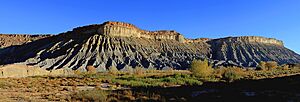Blue Valley (Wayne County, Utah) facts for kids
Blue Valley is a unique area in Utah, located near the Fremont River. It stretches from the Caineville Reef to Hanksville, Utah. This special valley is about 15 miles east of Capitol Reef National Park.
It gets its name, Blue Valley, from the striking blue color of the rocks found there. These rocks are mostly made of a type of stone called Mancos Shale. This shale is the main rock formation in the Fremont River valley at this elevation.
Contents
What Makes Blue Valley Blue?
The Story of Mancos Shale
Blue Valley is famous for its blue landscape. This color comes from a type of rock known as Mancos Shale. Shale is a soft rock formed from mud and clay over millions of years. The specific minerals in Mancos Shale give it a distinct blue-gray tint.
When you look across the valley, especially after a rain, the blue color of the shale becomes even more noticeable. This unique geology makes Blue Valley a very interesting place to visit and study. It shows how different rocks can shape the look of our planet.
A Look into Blue Valley's Past
Early Settlements and Pioneers
Blue Valley has a rich history, especially concerning its early settlers. In the late 1880s, American pioneers, many of whom were Mormon pioneers, began to settle in this area. They came to build new lives, focusing on farming and ranching.
These communities grew along the Fremont River. The river was essential for their farms, providing water for crops and livestock. People worked hard to create irrigation systems to bring water from the river to their fields.
The Mystery of Ghost Towns
Today, Blue Valley is home to several ghost towns. These are places where people once lived and worked, but are now abandoned. Some of the ghost towns in Blue Valley include Caineville, Giles, and a place called Elephant.
These towns were once busy communities. Families lived there, children played, and farmers tended their lands. But something happened that caused everyone to leave.
Why Towns Became Empty
The reason these towns became ghost towns is quite sad. In 1910, the Fremont River experienced severe flooding. The floodwaters were powerful and caused a lot of damage.
Many farms were washed away by the strong currents. The important irrigation systems, which brought water to the crops, were destroyed. The river itself changed, becoming lower in elevation. This made it even harder to get water to the remaining farms.
Because of this widespread destruction, the settlers could no longer farm or ranch successfully. They had no choice but to abandon their homes and move elsewhere. This is why Blue Valley, despite its beautiful blue landscape, holds the quiet stories of these lost communities.


